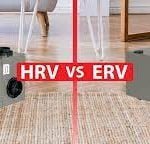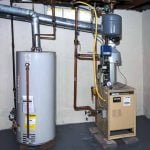Benefits of VRF: According to a report by MarketsandMarkets in November 2023, the Variable Refrigerant Flow (VRF) system market was USD 17.6 billion in 2020 and is expected to reach USD 31.9 billion by 2025, growing at a CAGR of 12.7% between 2020 and 2025. VRF systems are highly energy-efficient and provide effective temperature regulation, making them an excellent choice for commercial buildings in the US. While they are already the predominant HVAC technology in Asia, they are quickly gaining popularity in the US due to their numerous benefits.
What is VRF?
VRF is a type of HVAC system that uses refrigerant as the medium to transfer heat between indoor and outdoor units. Unlike traditional systems with only one compressor and one refrigerant circuit, VRF systems have multiple compressors and refrigerant circuits that can operate independently.
This means that VRF systems can adjust the refrigerant flow and the capacity of each compressor according to the demand of each zone, providing more flexibility and efficiency. Additionally, VRF systems can simultaneously heat and cool different zones with the help of heat recovery technology, which transfers heat from cooling zones to heating zones or vice versa.
How Does VRF Work?
VRF systems consist of three main components: an outdoor unit, indoor units, and refrigerant piping. The outdoor unit is the system’s central component, which houses inverter-driven compressors that adjust speed and output as required. Indoor units, such as wall-mounted or ceiling-mounted units, distribute cooled or heated air to specific zones. Refrigerant piping links outdoor and indoor units, transferring heat between them. You can read more about Heat Pump Vs VRF.
A central controller manages VRF system operations by communicating with outdoor and indoor units. It regulates refrigerant flow and compressor capacity based on set points and zone loads. The controller also monitors system performance and detects faults. Integrating with building automation systems enhances functionality, providing a comprehensive solution for your building’s needs.
What Are the Benefits of VRF?
Here are some valuable Benefits of VRF system:
- Energy efficiency
- Comfort and flexibility
- Air quality and reliability
- Noise reduction
- Space saving
- Easy installation and operation
- Environmental friendliness
- Fewer breakdowns and less downtime

Energy efficiency
VRF systems can save your energy and money by regulating the refrigerant flow and compressor capacity based on the demand of each zone. This decreases energy usage and system wear and tear. VRF systems can also collect heat from the cooling process to heat other zones, enhancing efficiency. According to some sources, VRF systems can lower your energy use by 25% to 50% compared to conventional systems.
Comfort and flexibility
VRF systems are an excellent solution for providing comfort and versatility in buildings. They can simultaneously supply cooled or heated air to multiple zones, allowing for different temperature and humidity settings in different spaces like offices, conference rooms, or lobbies. This helps to accommodate individual comfort preferences.
VRF systems are efficient as they respond to changing building loads by regulating cooling or heating based on occupancy, weather, and season. Due to their design, which includes smaller and lighter equipment, larger pipe lengths, and reduced ductwork, VRF systems are suitable for a wide range of building types.
Air quality and reliability
VRF systems are a great way to improve your HVAC system’s dependability and air quality. These systems work by exchanging stale indoor air with fresh outdoor air while filtering out contaminants such as dust, allergies, bacteria, and viruses. In addition, they can help regulate humidity levels, prevent mold and mildew growth, and address condensation and moisture issues. With their multiple independent compressors and balanced load rotation, VRF systems are more durable and reliable, leading to a longer lifespan for your system.
Noise reduction
VRF systems can lower noise levels by using inverter-driven compressors that can vary the system’s speed and output rather than turning on and off like traditional compressors. This decreases the system’s noise and vibration. VRF systems can further reduce interior unit noise by using variable-speed fans and electronically commutated motors that can modify airflow and fan speed based on the load of each zone. VRF systems can also reduce external unit noise by positioning it away from the building or employing sound attenuation devices such as silencers or enclosures.
Space saving
By using smaller and lighter equipment, longer pipe lengths, and less ducting than conventional systems, VRF systems can save space in your building. This means that VRF systems can be installed in confined locations such as attics, basements, or closets without needing dedicated maintenance rooms or service shafts. This frees up important real estate space in your building, which you can utilize for other purposes such as storage, office space, or retail.
Don’t forget to learn more about VAV Vs AHU: Understanding The Difference
Easy installation and operation
VRF systems are easy to install and operate because they don’t require complex wiring, piping, or controllers. The setup is simplified by using a simple two-pipe system that connects the outdoor and indoor units and a single communication cable to connect the controller and indoor units. The plug-and-play design allows indoor units to be added or removed without affecting the system’s operation. VRF systems come with a user-friendly controller that enables remote or central monitoring and adjustment of performance and parameters such as temperature, humidity, fan speed, and mode.
Benefits of VRF system – Environmental friendliness
VRF systems are designed to be environmentally friendly, utilizing less energy and refrigerant than conventional ones. The inverter-driven compressors regulate speed and output instead of the traditional on/off cycles, which reduces energy consumption and greenhouse gas emissions. The variable refrigerant flow adjusts according to each zone’s demand, which minimizes refrigerant charge and lowers the risk of leakage. VRF systems use refrigerants with low global warming and ozone depletion potential, such as R-410A or R-32, further contributing to their eco-friendly profile.
Fewer breakdowns and less downtime
VRF systems are designed to reduce the risk of breakdowns and downtime using multiple independent compressors. The rotation of the compressor operation helps balance the load, extending the system’s lifespan. If one compressor fails, the others can seamlessly take over, maintaining system operation without compromising comfort or efficiency in each zone. This shared workload reduces stress on the system, preventing premature failures and costly repairs. VRF systems also have fault detection and diagnostics features that promptly alert the controller and technician, streamlining troubleshooting and maintenance processes.
Don’t forget to learn more about Heat Pump Blowing Cold Air| What Are The Causes And How To Fix.
Benefits of VRF ~ Conclusion
VRF technology offers energy efficiency, comfort, flexibility, air quality, reliability, noise reduction, space-saving, easy installation, and operation. It adjusts refrigerant flow and compressor capacity to each zone’s demand, simultaneously providing cooled or heated air to different zones. VRF systems require smaller, lighter equipment, longer pipe lengths, and less ductwork than conventional systems, making them suitable for various building types.





